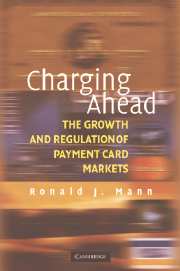Book contents
- Frontmatter
- Contents
- Figures and Tables
- Acknowledgments
- Introduction
- PART I THE BASICS OF PAYMENT CARDS
- 1 Paper or Plastic? The Functionality of Payment Systems
- 2 The Mechanics of Payment Card Transactions
- PART II EASY MONEY
- PART III THE PUZZLE OF PAYMENT CARDS
- PART IV REFORMING PAYMENT SYSTEMS
- PART V OPTIMIZING CONSUMER CREDIT MARKETS AND BANKRUPTCY POLICY
- Conclusion
- Appendix: Country-Level Data
- Notes
- Bibliography
- Index
2 - The Mechanics of Payment Card Transactions
Published online by Cambridge University Press: 06 July 2010
- Frontmatter
- Contents
- Figures and Tables
- Acknowledgments
- Introduction
- PART I THE BASICS OF PAYMENT CARDS
- 1 Paper or Plastic? The Functionality of Payment Systems
- 2 The Mechanics of Payment Card Transactions
- PART II EASY MONEY
- PART III THE PUZZLE OF PAYMENT CARDS
- PART IV REFORMING PAYMENT SYSTEMS
- PART V OPTIMIZING CONSUMER CREDIT MARKETS AND BANKRUPTCY POLICY
- Conclusion
- Appendix: Country-Level Data
- Notes
- Bibliography
- Index
Summary
The distinctions among automated teller machine (ATM) cards, charge cards, credit cards, and debit cards are largely invisible to the ordinary user. Still, those differences are critical to informed policymakers. To set the stage, this chapter discusses the mechanics of credit and debit card transactions, providing basic information on the economics of payment cards, primarily from the perspective of the merchant.
The Credit Card Transaction
Most credit card transactions involve four participants (depicted in Figure 2.1): a purchaser that pays with a credit card, an issuer that issues the credit card, a merchant that sells goods or services, and an acquirer that collects payment for the merchant. The acquirer is so named because it acquires the transaction from the merchant and then processes it to obtain payment from the issuer. In American Express and Discover transactions, the entity that issues the card also acquires the transaction. That arrangement is called a three-party or closed-loop system.
Although the purchaser, issuer, merchant, and acquirer are the nominal parties to the transaction, the network under which the card has been issued (usually Visa or MasterCard) is also involved. The networks (associations of member banks that issue Visa or MasterCard branded cards) provide information and transaction-processing services with respect to the transaction between the acquirer and the issuer. For example, when an acquirer has transactions involving Visa-branded cards, it will use VisaNet to communicate with the issuer of the card to obtain authorization and payment for the transaction.
- Type
- Chapter
- Information
- Charging AheadThe Growth and Regulation of Payment Card Markets around the World, pp. 20 - 34Publisher: Cambridge University PressPrint publication year: 2006
- 1
- Cited by

